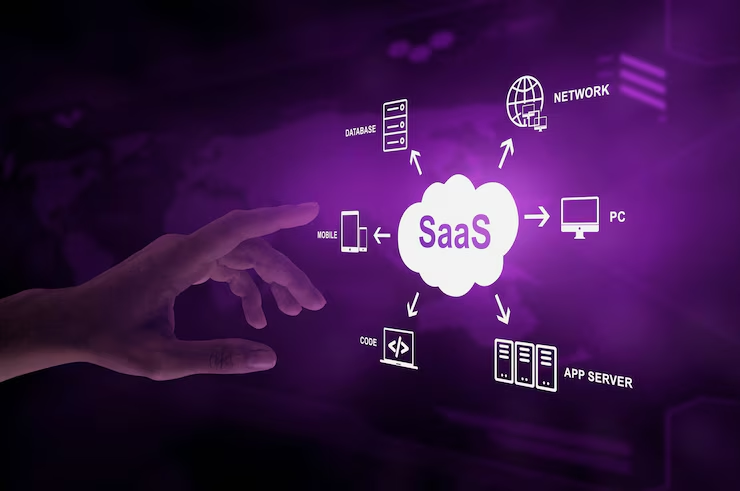The Software as a Service (SaaS) business model has revolutionized how businesses access and use software applications. Traditionally, software was purchased and installed on individual computers, leading to high upfront costs and maintenance burdens. However, the SaaS model allows users to access applications via the internet, streamlining costs, reducing maintenance, and enabling greater flexibility. This blog post delves into the SaaS business model for web applications, its benefits, challenges, and how it relates to web application development companies, iOS app development, and web design and development.
What is SaaS?
SaaS is a cloud-based service where software is hosted on external servers and delivered over the internet. Users subscribe to the software on a monthly or yearly basis, eliminating the need for extensive hardware and maintenance. This model allows companies to access software solutions from any device with an internet connection, promoting flexibility and scalability.
Key Characteristics of SaaS
- Subscription-Based: SaaS applications are typically offered on a subscription basis, allowing users to pay monthly or annually for access.
- Accessibility: SaaS applications can be accessed from any device with an internet connection, enhancing mobility and collaboration.
- Automatic Updates: The SaaS provider is responsible for maintaining and updating the software, ensuring that users always have access to the latest features and security enhancements.
- Scalability: SaaS solutions can easily scale to accommodate growing user bases or additional features, making them ideal for businesses of all sizes.
The Benefits of the SaaS Business Model
The SaaS model offers several advantages for businesses, including:
1. Cost Efficiency
One of the most significant benefits of SaaS is cost savings. Businesses no longer need to invest in expensive hardware or software licenses. Instead, they can subscribe to services that fit their needs, allowing for predictable budgeting.
2. Accessibility and Flexibility
With SaaS, users can access applications from anywhere, whether in the office, at home, or on the go. This level of accessibility fosters collaboration among teams, especially for businesses with remote workers or multiple locations.
3. Reduced Maintenance
SaaS providers handle maintenance and updates, freeing up internal IT resources to focus on strategic initiatives rather than routine maintenance tasks. This allows companies to invest more in their core competencies.
4. Rapid Deployment
SaaS applications can be deployed quickly, often requiring little more than a web browser and an internet connection. This rapid deployment allows businesses to start using the software almost immediately, speeding up time to value.
5. Enhanced Collaboration
SaaS applications often come with built-in collaboration tools, enabling teams to work together in real time, share documents, and communicate more effectively. This capability can lead to increased productivity and innovation.
Challenges of the SaaS Business Model
While SaaS offers numerous benefits, it also presents challenges that businesses must navigate:
1. Security Concerns
Storing sensitive data on external servers raises security concerns for many businesses. Companies must ensure that their SaaS providers implement robust security measures to protect against data breaches and unauthorized access.
2. Dependence on Internet Connectivity
SaaS applications rely heavily on internet connectivity. Any outages or slow connections can disrupt access to critical applications, impacting productivity.
3. Limited Customization
Many SaaS solutions are designed for a broad audience, which can limit customization options for specific business needs. Organizations may need to adapt their workflows to fit the software rather than the other way around.
4. Subscription Costs
While the initial costs of SaaS can be lower than traditional software, subscription fees can accumulate over time. Businesses must evaluate the long-term cost implications of their subscriptions.
The Role of Web Application Development Companies in SaaS
Web application development companies play a crucial role in the SaaS ecosystem. These companies design, develop, and maintain SaaS applications, ensuring that they meet the needs of users and stay competitive in the market.
1. Understanding Client Needs
A successful web application development company must first understand the specific needs of its clients. This involves conducting thorough research and collaborating with stakeholders to identify pain points and areas for improvement.
2. Creating User-Centric Designs
User experience (UX) is critical in SaaS applications. Development companies must focus on creating intuitive and user-friendly interfaces that enhance usability and engagement. This involves conducting usability testing and iterating on designs based on user feedback.
3. Implementing Scalable Solutions
As businesses grow, their software needs often change. Web application development companies must design SaaS applications that can scale effectively, accommodating an increasing number of users and additional features without compromising performance.
4. Ensuring Security and Compliance
With data security being a top concern for many businesses, web application development companies must prioritize security in their SaaS solutions. This includes implementing encryption, secure authentication, and compliance with industry standards and regulations.
5. Providing Ongoing Support and Maintenance
Once a SaaS application is launched, the development company must provide ongoing support and maintenance to address any issues and implement updates. This ensures that the application remains functional and up-to-date in a rapidly changing technology landscape.
Integrating iOS App Development into SaaS
In today’s mobile-driven world, integrating iOS app development into SaaS offerings is increasingly important. Many users expect access to SaaS applications via mobile devices, necessitating the development of dedicated mobile applications.
1. Enhancing Accessibility
By developing an iOS app for their SaaS offering, companies can provide users with easy access to their services on the go. This enhances the user experience and meets the growing demand for mobile accessibility.
2. Leveraging Mobile Features
iOS apps can leverage native features of mobile devices, such as push notifications, camera access, and location services, enhancing the functionality of the SaaS application. This allows businesses to create more engaging and interactive experiences for their users.
3. Increasing User Engagement
Mobile apps can facilitate higher user engagement through features like offline access, real-time notifications, and streamlined workflows. This can lead to increased usage and customer satisfaction.
4. Integrating Analytics
iOS apps can incorporate analytics tools to track user behavior and engagement metrics. This data can help businesses refine their SaaS offerings and improve user experiences based on actual usage patterns.
The Importance of Web Design and Development in SaaS
Web design and development are critical components of a successful SaaS application. A well-designed application enhances usability and drives user satisfaction, while effective development ensures that the application functions smoothly and efficiently.
1. Creating a Compelling User Interface (UI)
A visually appealing and intuitive UI is essential for attracting and retaining users. Web designers must prioritize aesthetics while ensuring that the interface is easy to navigate and user-friendly.
2. Ensuring Responsive Design
With users accessing applications on various devices, responsive design is crucial. SaaS applications must adapt seamlessly to different screen sizes and resolutions, ensuring a consistent user experience across devices.
3. Optimizing Performance
Web development practices must focus on optimizing application performance to ensure fast loading times and smooth interactions. This involves using efficient coding practices, optimizing images, and minimizing unnecessary scripts.
4. Implementing SEO Best Practices
While SaaS applications may not require traditional SEO strategies, implementing best practices can improve visibility and attract potential users. This includes optimizing landing pages and content for relevant keywords.
Conclusion
The SaaS business model for web applications has transformed how businesses access and utilize software solutions. With benefits such as cost efficiency, accessibility, and reduced maintenance, it has become a preferred choice for many organizations. However, challenges such as security concerns and dependency on internet connectivity remain.
Web application development companies play a pivotal role in the success of SaaS applications, from understanding client needs to implementing scalable solutions and ensuring security. Moreover, integrating iOS app development enhances accessibility and user engagement, while effective web design and development are essential for creating user-friendly interfaces.
As the demand for SaaS solutions continues to grow, businesses must stay informed about the latest trends and best practices in web application development, iOS app development, and web design and development. Embracing these practices will enable companies to thrive in the competitive SaaS landscape and deliver exceptional value to their users.











